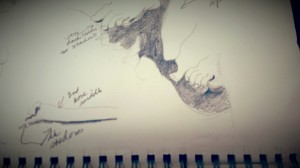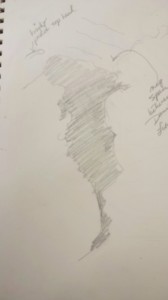Phase 6 – Mind the Negative Spaces—and Mine, Them, as Well
14 - 12
2013
Today I want to share one of my single most guiding secrets to mastering a project of this size and fulfilling my commission to paint a stunning likeness of the Daniel in the Lions’ Den that hangs in the National Gallery of Art in Washington, D.C.
That secret would rest in finding and acknowledging the negative spaces in any work. By the correctness of the negative spaces, the whole is judged. The negative spaces join the parts. I have mentioned this before, but in the middle to advanced stages, these spots are re-delineated and perfected, their virtual lengths and distances, ins and outs.
There are innumerable negative spaces in a painting, so I will go into detail in only three spots, and try to show you how mastering the relationships in negative spaces went a long way towards resolving the whole painting.
First, to bring everyone aboard—a “negative” space is the space surrounding an object and does not include the positive image of the object itself. If you think of camera negatives, you are not far off. It is these spots which give the character of the painting. No matter how much likeness you transfer onto an object, if you do not echo the spaces in between correctly, your painting will look all askew.
 from my sketchbook, sketch made while I was in Washington, D.C., visiting Rubens’ painting
from my sketchbook, sketch made while I was in Washington, D.C., visiting Rubens’ painting
One of the first major conjunctions and well-formed negative spaces I saw was the area surrounding the base of Daniel’s feet. I drew this section as though it were an object itself. The best part of this is that getting the negative space right sets in, in this case, the two tails of the drapes, white and red, both Daniel’s feet, the mane on the lion’s left (our right side) which nails down the drowsy lion’s position, and shows the profile of hairs in his mane.
If you are painting by object alone, you might not get them in the right relationship to one another and that alone would sound an immediate jarring note to the whole work—a mistake far greater than a slightly larger or smaller proportion of an object would give.
If you look at the actual painting I have pulled the negative space from, you can see a larger negative shape which includes the red drape, and not just the sub-negative black space, the smaller one, indicated by the drawing. The larger negative space includes the red drape, the white drape which forms a “V” and thus defines the distance between Daniel’s legs, even to the setting up of the mane hanging down by the ear of the snarling lion on the right as we face it, on his left side as viewed by us.
![1175134_595792013806191_1972117313_n[1]](https://joriginals.net/wp-content/uploads/2013/12/1175134_595792013806191_1972117313_n1-168x300.jpg) Next to these negative spaces is another, easily seen in this same snippet of Daniel’s lower half—this space begins a long, narrow horizontal space that starts from the far left with the groggy lion on the left side, travels under his whole face and extended mane, follows the shadow, turns and follows the snarling lion’s extended foot, establishes the rise on his upper toe and bounces up and down over the bones below it. The negative space establishes: drowsy lion’s underside, end of shadow under Daniel’s grounded foot, the foot of the snarling lion, and four or five bones, showing me exactly where I needed to correct the drawing and therefore, the painting.
Next to these negative spaces is another, easily seen in this same snippet of Daniel’s lower half—this space begins a long, narrow horizontal space that starts from the far left with the groggy lion on the left side, travels under his whole face and extended mane, follows the shadow, turns and follows the snarling lion’s extended foot, establishes the rise on his upper toe and bounces up and down over the bones below it. The negative space establishes: drowsy lion’s underside, end of shadow under Daniel’s grounded foot, the foot of the snarling lion, and four or five bones, showing me exactly where I needed to correct the drawing and therefore, the painting.
This is quite a windfall for an artist mapping out so many distinct details by clumping them into a negative-space image that orders their placement.
Above the snoozing or drowsy lion is another section of negative space, that formed by a wide-open “V” of the top of Daniel’s crossed foot and follows the upper mane of drowsy lion, turning and running up the leg of the standing lion, runs along his belly, down the inside of the final leg, along the ledge of the rock surface and the edge of the curled white drape, following the white drape along Daniel’s leg and down to the topside of the big toe. This area joins the lion, Daniel’s leg and bottom drape, the standing lion and captures his legs and tail and a small triangle of light, plus the whole rock inside.
I hope you are beginning to see how useful the notion of negative space is in joining objects—in my opinion, this technique is so far superior to grid work that throws in unsympathetic, opposed straight lines as to be virtually confusing, an act that would obliterate the relative simplicity of the free shape of objects joined by negative space.
 Let’s take one more drawing of mine which you can see in the same part of my painting shown in color here. This is the shape between Daniel and the roaring lion which forms another “V,” descending. This shape defines the entire right side of Daniel (seen as on our right) and the entire left side of the roaring lion seen on our left. It even takes in his teeth and his tongue. Drawing this negative shape as a positive fits all of the segments of Daniel and the roaring lion properly in place without the tedious and lengthy mistakes made by using a grid.
Let’s take one more drawing of mine which you can see in the same part of my painting shown in color here. This is the shape between Daniel and the roaring lion which forms another “V,” descending. This shape defines the entire right side of Daniel (seen as on our right) and the entire left side of the roaring lion seen on our left. It even takes in his teeth and his tongue. Drawing this negative shape as a positive fits all of the segments of Daniel and the roaring lion properly in place without the tedious and lengthy mistakes made by using a grid.
This is much easier on the eyes, more intuitive, and allows forgivingly for many small differences. In conclusion, this is a tool that can be mined to the full extent of the artist’s skill, intelligence, and patience.
I’m excited, now. Let’s move on to the next phase of layering, one which begins to bring the final clarity.

Leave A Reply
You must be logged in to post a comment.